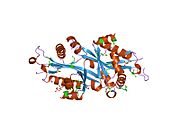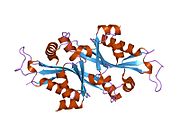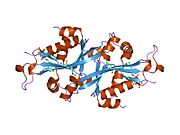SAT1 (gene)
| SAT1 | |||||||||||||||||||||||||||||||||||||||||||||||||||
|---|---|---|---|---|---|---|---|---|---|---|---|---|---|---|---|---|---|---|---|---|---|---|---|---|---|---|---|---|---|---|---|---|---|---|---|---|---|---|---|---|---|---|---|---|---|---|---|---|---|---|---|
 | |||||||||||||||||||||||||||||||||||||||||||||||||||
| |||||||||||||||||||||||||||||||||||||||||||||||||||
| Identifiers | |||||||||||||||||||||||||||||||||||||||||||||||||||
| Aliases | SAT1, DC21, KFSD, KFSDX, SAT, SSAT, SSAT-1, spermidine/spermine N1-acetyltransferase 1 | ||||||||||||||||||||||||||||||||||||||||||||||||||
| External IDs | OMIM: 313020; MGI: 98233; HomoloGene: 37716; GeneCards: SAT1; OMA:SAT1 - orthologs | ||||||||||||||||||||||||||||||||||||||||||||||||||
| |||||||||||||||||||||||||||||||||||||||||||||||||||
| |||||||||||||||||||||||||||||||||||||||||||||||||||
| |||||||||||||||||||||||||||||||||||||||||||||||||||
| |||||||||||||||||||||||||||||||||||||||||||||||||||
| Wikidata | |||||||||||||||||||||||||||||||||||||||||||||||||||
| |||||||||||||||||||||||||||||||||||||||||||||||||||
Diamine acetyltransferase 1 is an enzyme that in humans is encoded by the SAT1 gene found on the X chromosome.[4][5][6]
Function
Spermidine/spermine N(1)-acetyltransferase (SPD/SPM acetyltransferase) is a rate-limiting enzyme in the catabolic pathway of polyamine metabolism. It catalyzes the N(1)-acetylation of spermidine and spermine and, by the successive activity of polyamine oxidase, spermine can be converted to spermidine and spermidine to putrescine.[6] The SAT1 gene is used to help regulate polymamies levels inside the cell by regulating their transport in and out of the cell.[7][8] SAT1 is also involved in the first step to synthesize N-acetylputrescine from putrescine.[9] PMF1 and NRF2 work together to transcript the SAT1 gene.[10]
Structure
The SAT1 gene is 3,069 base pairs long. There are 171 amino acids and its molecular mass is 20024 Da Daltons). In 1992 at The Johns Hopkins University School of Medicine, Lei Xiao and several others cloned over 4000 base pairs of the region containing the coding sequence of the SAT1 gene also referred to as SSAT-1, SSAT,SAT,KFSD,DC21, KFSDX gene.[11] This gene is located on the X chromosome in the region Xp22.1. The primer extension analysis indicated that the transcription started 179 bases upstream from the translational start site. Furthermore, they determined that it appeared to be controlled by a "TATA-less" promoter. Normally, there would be a TATA box where RNA polymerase II would be involved in assisting with initiation by properly positioning the enzyme, however in a TATA-less promoter situation the TATA box is absent.[12]
Clinical significance
An association with keratosis follicularis spinulosa decalvans (KFSD) has been suggested.[13] Data shows that keratosis follicularis spinulosa decalvans could be caused by mutations in the SAT 1 gene. KSFD is also believed to be X-linked, which helps prove that the disease is caused by a mutation found in the SAT 1 gene which is located on the X chromosome.[14] The mutation most likely occurs at the location Xp22.1.[15] KDSF mostly affects men, which makes sense for it to be an X-linked disease, caused by a mutation of the SAT1 gene.[16]
Elevated levels of RNA transcripts of SAT1 in the bloodstream have been associated with a higher risk of suicide.[17][18][19]
The SAT1 gene has implications with NLS-2 Neu-Laxova syndrome, type 2 (NLS). It is inherited as an autosomal recessive trait and is considered a rare lethal congenital disorder. Severe growth delays before birth including low birth weight and shorter than normal length occur. After birth, outward observable characteristics include significant small skull size (microcephaly), wider than normal spaced eyes, sloped forehead and other disfiguring facial features. There may also be random places of fluid retention (edema) throughout the body and permanent joint limitations due to limb malformations. NLS can be detected in pregnant woman with ultrasound examination. In some people of Neu-Laxova syndrome, other areas were severely affected such as skin, genitals, and other internal organs including the heart. Males and females are equally affected and could be most closely associated with persons of Pakistani origin. However, there have been cases reported in several other diverse backgrounds. The prognosis is extremely poor and in most cases the infant dies shortly after birth or are stillborn. The first documented and reported case in Japan involved a baby girl exhibiting microcephaly, severe edema, and other symptoms. In her case she had a condition known as congenital vertical talus or rocker-feet. The foot is abnormally shaped in a convex position. She survived 134 days.[20][21][22]
The SAT1 gene plays a vital role in the catabolic pathway of polyamine metabolism. It acts as a rate-limiting enzyme in the pathway of polyamine metabolism, meaning it is significant in the involvement of cell survival. Research has shown that the tumor protein known as p53 can specifically target the SAT1 gene that results in ferroptotic cell-death. Ferroptosis is when a death of a cell is caused by an iron-dependent accumulation of a lipid.[23]
References
- ^ a b c GRCm38: Ensembl release 89: ENSMUSG00000025283 – Ensembl, May 2017
- ^ "Human PubMed Reference:". National Center for Biotechnology Information, U.S. National Library of Medicine.
- ^ "Mouse PubMed Reference:". National Center for Biotechnology Information, U.S. National Library of Medicine.
- ^ Casero RA, Celano P, Ervin SJ, Applegren NB, Wiest L, Pegg AE (January 1991). "Isolation and characterization of a cDNA clone that codes for human spermidine/spermine N1-acetyltransferase". The Journal of Biological Chemistry. 266 (2): 810–4. PMID 1985966.
- ^ Xiao L, Celano P, Mank AR, Griffin C, Jabs EW, Hawkins AL, Casero RA (September 1992). "Structure of the human spermidine/spermine N1-acetyltransferase gene (exon/intron gene organization and localization to Xp22.1)". Biochemical and Biophysical Research Communications. 187 (3): 1493–502. doi:10.1016/0006-291X(92)90471-V. PMID 1417826.
- ^ a b "Entrez Gene: SAT1 spermidine/spermine N1-acetyltransferase 1".
- ^ "SAT1 Gene". GeneCards.
- ^ Pegg AE (June 2008). "Spermidine/spermine-N(1)-acetyltransferase: a key metabolic regulator". American Journal of Physiology. Endocrinology and Metabolism. 294 (6): E995–1010. doi:10.1152/ajpendo.90217.2008. PMID 18349109.
- ^ Universal protein resource accession number P21673 for "SAT1 - Diamine acetyltransferase 1 - Homo sapiens (Human)" at UniProt.
- ^ Online Mendelian Inheritance in Man (OMIM): Spermidine/spermine n(1)-acetyltransferase 1; SAT1 - 313020
- ^ Wang, C.; Ruan, P.; Zhao, Y.; Li, X.; Wang, J.; Wu, X.; Liu, T.; Wang, S.; Hou, J.; Li, W.; Li, Q.; Li, J.; Dai, F.; Fang, D.; Wang, C.; Xie, S. (2017). "Spermidine/spermine N1-acetyltransferase regulates cell growth and metastasis via AKT/β-catenin signaling pathways in hepatocellular and colorectal carcinoma cells". Oncotarget. 8 (1): 1092–1109. doi:10.18632/oncotarget.13582. PMC 5352037. PMID 27901475.
- ^ "Neu Laxova Syndrome". GARD Genetic and Rare diseases Information Center. Retrieved 19 November 2018.
- ^ Gimelli G, Giglio S, Zuffardi O, Alhonen L, Suppola S, Cusano R, Lo Nigro C, Gatti R, Ravazzolo R, Seri M (September 2002). "Gene dosage of the spermidine/spermine N(1)-acetyltransferase ( SSAT) gene with putrescine accumulation in a patient with a Xp21.1p22.12 duplication and keratosis follicularis spinulosa decalvans (KFSD)". Human Genetics. 111 (3): 235–41. doi:10.1007/s00439-002-0791-6. PMID 12215835.
- ^ "Keratosis follicularis spinulosa decalvans". Genetic and Rare Diseases Information Center (GARD) – an NCATS Program. Retrieved 2018-11-16.
- ^ "Keratosis Follicularis Spinulosa Decalvans, X-Linked". Hereditary Ocular Diseases. Retrieved 2018-11-16.
- ^ "SAT1 gene". Genetics Home Reference. Retrieved 17 November 2018.
- ^ Honor Whiteman (21 August 2013). "'Biological signal' of suicide risk found in blood". Medical News Today. Retrieved 21 August 2013.
- ^ Le-Niculescu H, Levey DF, Ayalew M, Palmer L, Gavrin LM, Jain N, Winiger E, Bhosrekar S, Shankar G, Radel M, Bellanger E, Duckworth H, Olesek K, Vergo J, Schweitzer R, Yard M, Ballew A, Shekhar A, Sandusky GE, Schork NJ, Kurian SM, Salomon DR, Niculescu AB (December 2013). "Discovery and validation of blood biomarkers for suicidality". Molecular Psychiatry. 18 (12): 1249–64. doi:10.1038/mp.2013.95. PMC 3835939. PMID 23958961.
- ^ Le-Niculescu H, Levey DF, Ayalew M, Palmer L, Gavrin LM, Jain N, et al. (December 2013). "Discovery and validation of blood biomarkers for suicidality". Molecular Psychiatry. 18 (12): 1249–64. doi:10.1038/mp.2013.95. PMC 3835939. PMID 23958961.
{{cite journal}}: Unknown parameter|lay-source=ignored (help); Unknown parameter|lay-url=ignored (help) - ^ Hirota T, Hirota Y, Asagami C, Muto M (March 1998). "A Japanese case of Neu-Laxova syndrome". The Journal of Dermatology. 25 (3): 163–6. doi:10.1111/j.1346-8138.1998.tb02373.x. PMID 9575678.
- ^ Barekatain B, Sadeghnia A, Rouhani E, Soofi GJ (2018). "A New Case of Neu-Laxova Syndrome: Infant with Facial Dysmorphism, Arthrogryposis, Ichthyosis, and Microcephalia". Advanced Biomedical Research. 7: 68. doi:10.4103/abr.abr_143_17. PMC 5952546. PMID 29862217.
{{cite journal}}: CS1 maint: unflagged free DOI (link) - ^ Amini E, Azadi N, Sheikh M (March 2017). "New Insights on Genetic Features of Neu-Laxova Syndrome". Iranian Journal of Neonatology IJN. 8 (1): 40–2.
- ^ Stockwell BR, Friedmann Angeli JP, Bayir H, Bush AI, Conrad M, Dixon SJ, et al. (October 2017). "Ferroptosis: A Regulated Cell Death Nexus Linking Metabolism, Redox Biology, and Disease". Cell. 171 (2): 273–285. doi:10.1016/j.cell.2017.09.021. PMC 5685180. PMID 28985560.
Further reading
- Lake JA, Carr J, Feng F, Mundy L, Burrell C, Li P (February 2003). "The role of Vif during HIV-1 infection: interaction with novel host cellular factors". Journal of Clinical Virology. 26 (2): 143–52. doi:10.1016/S1386-6532(02)00113-0. PMID 12600646.
- Xiao L, Celano P, Mank AR, Pegg AE, Casero RA (August 1991). "Characterization of a full-length cDNA which codes for the human spermidine/spermine N1-acetyltransferase". Biochemical and Biophysical Research Communications. 179 (1): 407–15. doi:10.1016/0006-291X(91)91385-P. PMID 1652956.
- Libby PR, Ganis B, Bergeron RJ, Porter CW (February 1991). "Characterization of human spermidine/spermine N1-acetyltransferase purified from cultured melanoma cells". Archives of Biochemistry and Biophysics. 284 (2): 238–44. doi:10.1016/0003-9861(91)90291-P. PMID 1989509.
- Casero RA, Celano P, Ervin SJ, Wiest L, Pegg AE (September 1990). "High specific induction of spermidine/spermine N1-acetyltransferase in a human large cell lung carcinoma". The Biochemical Journal. 270 (3): 615–20. doi:10.1042/bj2700615. PMC 1131776. PMID 2241897.
- Casero RA, Gabrielson EW, Pegg AE (August 1994). "Immunohistochemical staining of human spermidine/spermine N1-acetyltransferase superinduced in response to treatment with antitumor polyamine analogues". Cancer Research. 54 (15): 3955–8. PMID 8033120.
- Xiao L, Casero RA (January 1996). "Differential transcription of the human spermidine/spermine N1-acetyltransferase (SSAT) gene in human lung carcinoma cells". The Biochemical Journal. 313 (2): 691–6. doi:10.1042/bj3130691. PMC 1216962. PMID 8573111.
- Coleman CS, Huang H, Pegg AE (June 1996). "Structure and critical residues at the active site of spermidine/spermine-N1-acetyltransferase". The Biochemical Journal. 316 (3): 697–701. doi:10.1042/bj3160697. PMC 1217406. PMID 8670140.
- Bordin L, Vargiu C, Colombatto S, Clari G, Testore G, Toninello A, Grillo MA (December 1996). "Casein kinase 2 phosphorylates recombinant human spermidine/spermine N1-acetyltransferase on both serine and threonine residues". Biochemical and Biophysical Research Communications. 229 (3): 845–51. doi:10.1006/bbrc.1996.1890. PMID 8954982.
- Bettuzzi S, Davalli P, Astancolle S, Carani C, Madeo B, Tampieri A, Corti A, Saverio B, Pierpaola D, Serenella A, Cesare C, Bruno M, Auro T, Arnaldo C (January 2000). "Tumor progression is accompanied by significant changes in the levels of expression of polyamine metabolism regulatory genes and clusterin (sulfated glycoprotein 2) in human prostate cancer specimens". Cancer Research. 60 (1): 28–34. PMID 10646846.
- Simpson JC, Wellenreuther R, Poustka A, Pepperkok R, Wiemann S (September 2000). "Systematic subcellular localization of novel proteins identified by large-scale cDNA sequencing". EMBO Reports. 1 (3): 287–92. doi:10.1093/embo-reports/kvd058. PMC 1083732. PMID 11256614.
- Coleman CS, Pegg AE (August 2001). "Polyamine analogues inhibit the ubiquitination of spermidine/spermine N1-acetyltransferase and prevent its targeting to the proteasome for degradation". The Biochemical Journal. 358 (Pt 1): 137–45. doi:10.1042/0264-6021:3580137. PMC 1222041. PMID 11485561.
- Bordin L, Vargiu C, Clari G, Brunati AM, Colombatto S, Salvi M, Grillo MA, Toninello A (January 2002). "Phosphorylation of recombinant human spermidine/spermine N(1)-acetyltransferase by CK1 and modulation of its binding to mitochondria: a comparison with CK2". Biochemical and Biophysical Research Communications. 290 (1): 463–8. doi:10.1006/bbrc.2001.6204. PMID 11779193.
- Nikiforova NN, Velikodvorskaja TV, Kachko AV, Nikolaev LG, Monastyrskaya GS, Lukyanov SA, Konovalova SN, Protopopova EV, Svyatchenko VA, Kiselev NN, Loktev VB, Sverdlov ED (June 2002). "Induction of alternatively spliced spermidine/spermine N1-acetyltransferase mRNA in the human kidney cells infected by venezuelan equine encephalitis and tick-borne encephalitis viruses". Virology. 297 (2): 163–71. doi:10.1006/viro.2002.1456. PMID 12083816.
- Gimelli G, Giglio S, Zuffardi O, Alhonen L, Suppola S, Cusano R, Lo Nigro C, Gatti R, Ravazzolo R, Seri M (September 2002). "Gene dosage of the spermidine/spermine N(1)-acetyltransferase ( SSAT) gene with putrescine accumulation in a patient with a Xp21.1p22.12 duplication and keratosis follicularis spinulosa decalvans (KFSD)". Human Genetics. 111 (3): 235–41. doi:10.1007/s00439-002-0791-6. PMID 12215835.
- Tomitori H, Nenoi M, Mita K, Daino K, Igarashi K, Ichimura S (December 2002). "Functional characterization of the human spermidine/spermine N(1)-acetyltransferase gene promoter". Biochimica et Biophysica Acta (BBA) - Gene Structure and Expression. 1579 (2–3): 180–4. doi:10.1016/S0167-4781(02)00545-6. PMID 12427553.
- Izmailova E, Bertley FM, Huang Q, Makori N, Miller CJ, Young RA, Aldovini A (February 2003). "HIV-1 Tat reprograms immature dendritic cells to express chemoattractants for activated T cells and macrophages". Nature Medicine. 9 (2): 191–7. doi:10.1038/nm822. PMID 12539042.















